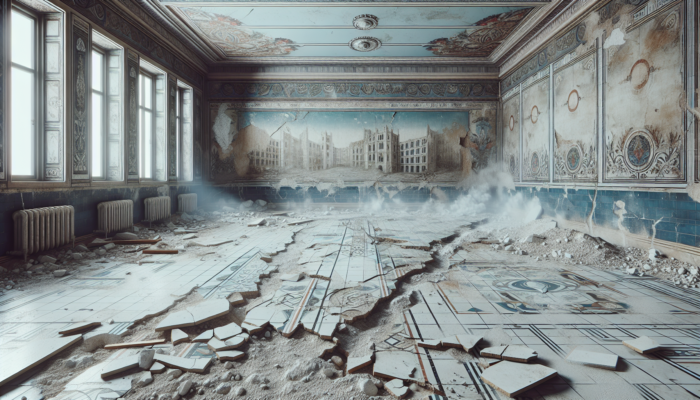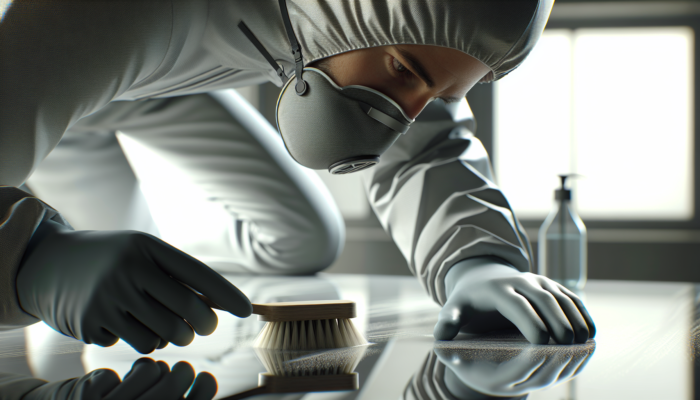1. Transform Your Home with Effective Quarry Tile Restoration Strategies
Restoring quarry tile flooring is much like providing your cherished floors with an exquisite makeover—think of it as dressing your favourite coat in a durable, protective raincoat. These unglazed clay tiles, which have been a popular choice in Victorian hallways and garden patios, perfectly combine timeless elegance with exceptional durability. In Richmond upon Thames, the restoration of period property flooring celebrates our rich architectural history, making the restoration of these tiles a far more desirable option than complete replacement. This approach not only preserves the aesthetic charm but also honours the craftsmanship of the past.
At Fabritec Tile Cleaning, located in New Malden (01372-664-337), we have witnessed countless homes undergo extraordinary transformations. Instead of discarding beautiful floors concealed beneath carpets or vinyl, our gentle bitumen removal techniques and clay floor revival methods reveal the inviting terracotta shades hidden underneath. Opting for restoration not only proves to be a wise financial investment over time but also serves as a creative pursuit that preserves the distinctive character of listed building flooring, allowing your home to retain its unique charm.
This comprehensive guide will take you through each step of the restoration process, starting from the initial inspection to the application of a breathable tile sealer. By the end of this resource, you will understand how traditional floor finishes and eco-friendly cleaning solutions work together to protect your heritage flooring, ensuring it remains beautiful for generations to come. [Insert Internal Link to Related Article]
2. Uncover the Distinctive Features of Quarry Tiles
Quarry tiles are renowned for their unglazed clay composition, which offers a natural matte finish and unmatched durability. Unlike modern ceramic tiles, which often feature shiny glazes, these clay quarry tiles have a porous, earthy texture that evolves with time, much like a well-loved leather armchair that gains character with use. Their unique attributes make them an ideal choice for both aesthetic and practical applications.
In the homes of Richmond, these tiles are frequently found in the following areas:
- Period entrances: Edwardian hallways and mudrooms where durable, slip-resistant flooring is crucial for safety and style.
- Garden patios: Rustic flooring that gracefully withstands outdoor weather while maintaining its visual appeal, making it perfect for outdoor entertaining.
- Kitchen nooks: Natural tile materials that retain warmth, creating a welcoming atmosphere underfoot, ideal for family gatherings.
The key differences between quarry tiles and contemporary tiles include:
| Feature | Quarry Tiles | Modern Ceramic |
|---|---|---|
| Porosity | High – encourages breathability and moisture management | Low – may trap moisture, leading to damage |
| Durability | Extremely robust, designed for longevity | Can be prone to chipping when glazed |
| Finish | Matte, unsealed tile surface | Glossy or satin finish, which can be slippery |
Due to their unsealed nature, quarry tiles necessitate proper tile sealing or a beeswax finish to prevent staining and efflorescence. In older UK homes where damp-proofing may be lacking, breathable sealers are essential to avoid moisture becoming trapped beneath the quarry tiles, which is vital for preserving their long-term integrity and beauty. [Insert Internal Link to Related Article]
3. Celebrate Richmond’s Architectural Heritage: Floors That Deserve Preservation
Richmond upon Thames is home to a wealth of period properties, including Georgian townhouses and Edwardian cottages, which often conceal remarkable treasures beneath contemporary coverings. These period home floors were originally laid with quarry tiles arranged in intricate geometric patterns, showcasing both durability and stunning visual appeal. Visualise them as a timeless tapestry, crafted from local clay and reflecting the historic kiln traditions unique to the region.
Prominent sites such as Kew Gardens and the surrounding conservation areas feature traditional tile work, demonstrating how historic flooring styles continue to be valued in both public and private settings. In neighbourhoods like St Margarets, many older village shops retain their original flooring—often a cherished aspect for those passionate about Victorian home restoration.
- Georgian layouts: Simple running bond or herringbone patterns commonly found in entrance halls.
- Edwardian motifs: Basket-weave designs typically seen in kitchens and mudrooms.
- Outdoor terraces: Rustic garden paving tiles that gracefully weather over time, adding character to outdoor spaces.
Preserving these floors goes beyond aesthetics; it pays homage to Richmond’s architectural legacy, sustaining the essence of your home. By choosing restoration over replacement, you honour the unique character that makes your property distinctive, ensuring its aesthetic and historical significance endure for future generations. [Insert Internal Link to Related Article]
4. Your Detailed Restoration Guide: Step-by-Step Instructions for Success
Revitalising quarry tiles requires a meticulous blend of assessment, cleaning, and protective measures. Approach this undertaking akin to preparing a cherished wooden table for varnishing—neglecting steps such as sanding or dusting is simply not an option. Follow these reliable guidelines for effective historic floor repair in your Richmond residence to achieve the best results.
Step 1: Thoroughly Inspect the Floor for Damage

- Examine for cracks and chips: Identify areas that may require tile replacement or lime mortar repairs to restore integrity.
- Assess damp spots: Look for efflorescence (the white dust) which indicates moisture ingress and requires attention.
Step 2: Perform a Dry Clean Without Introducing Moisture
Utilise a soft-bristled brush or a vacuum cleaner to remove loose grit and debris. At this stage, avoid using water to prevent the clay tiles from absorbing excess moisture, which can cause further damage.
Step 3: Carefully Remove Wax, Bitumen, or Paint Residues
Use an eco-safe cleaning product or a specialised bitumen remover. Allow the product to sit for the recommended duration, then carefully scrape away any residues. For particularly stubborn substances, repeat the process rather than increasing the chemical strength, preserving the integrity of the tiles.
Step 4: Conduct a Deep Clean with Alkaline Products

Utilise a pH-neutral or slightly alkaline clay tile cleaner diluted in accordance with the manufacturer's instructions. Gently scrub with a soft brush to lift ingrained dirt without damaging the tile surface, ensuring a thorough clean.
Step 5: Allow the Tiles to Dry Naturally
Ensure that the area is well-ventilated and the ambient temperature is appropriate. Avoid forced heating, as this can trap moisture beneath the tiles, potentially leading to long-term damage and integrity issues.
Step 6: Fill Gaps with Lime Mortar for Stability
Prepare lime mortar to a workable consistency and carefully fill any gaps. This traditional material adjusts alongside the tiles, thus preventing cracking and ensuring a long-lasting repair that supports the flooring.
Step 7: Apply Sealant and Finishing Touches (Indoors Only)
In thin layers, apply a breathable tile sealer or beeswax finish. This protective ‘raincoat' for your floor shields against stains while permitting moisture to escape, safeguarding the overall health of your tiles. [Insert Internal Link to Related Article]
5. Sidestep Common Pitfalls in Quarry Tile Restoration
Even experienced DIY enthusiasts may stumble upon simple mistakes that jeopardise the restoration of quarry tiles. Avoid these tile restoration pitfalls to protect your investment and preserve the character of your heritage flooring for years to come.
- Steer clear of harsh chemicals: Although quarry tiles are inherently robust, acid or bleach-based cleaners can etch the surface, dull the finish, or harm the surrounding lime mortar. Opt for pH-neutral or slightly alkaline products specifically formulated for historic clay tiles.
- Do not seal prematurely: Applying a sealant before the tiles have fully dried can trap moisture, resulting in efflorescence (that undesirable white dust) and potential lifting. After deep cleaning, allow at least 48–72 hours for natural drying in a well-ventilated environment.
- Refrain from using modern grout: Cement-based grouts are non-breathable, blocking the vapour-permeable nature of lime mortar. This mismatch can lead to cracking and moisture retention. Instead, choose lime mortar repairs to ensure proper moisture flow and stability.
- Avoid power washing: Excessive power washing can erode grout lines and dull the surface of unsealed quarry tiles. A gentle hand-brushing method is much safer for preserving the matte finish of your vintage tile.
- Limit sealant application: Thick layers of sealant can produce a glossy, artificial finish and may increase the risk of yellowing or peeling, especially with non-breathable products. Thin, layered applications tend to be more durable and aesthetically pleasing.
By steering clear of these DIY floor sealing blunders, you'll ensure that your quarry tiles in Richmond upon Thames remain both stunning and functional for many years ahead, enhancing the beauty of your home. [Insert Internal Link to Related Article]
6. Your Ultimate Resource for Sourcing Replacement Tiles in Richmond
Even with careful restoration efforts, you may encounter situations where tiles are missing or irreparably damaged. Fortunately, Richmond upon Thames offers excellent resources for locating reclaimed quarry tiles that match the original character of your flooring, ensuring a seamless integration into your space.
- Salvage yards: Explore Richmond Architectural Salvage or Surrey Salvage near New Malden. Inspect tiles in person to ensure that the clay tones and thickness correspond to your existing floor. Salvage yards typically stock reclaimed tiles in traditional reds, browns, and ochres, although availability may vary—visiting in person guarantees a suitable match.
- Local specialists: Local experts like Fabritec Tile Cleaning can assist you in sourcing reclaimed tiles that align with Victorian-era designs and traditional floor finishes, even if exact matches must be sourced independently through salvage yards or online suppliers.
- Online reclamation: UK websites such as Reclaim UK and Salvoweb specialise in architectural salvage—search for specific listings of quarry tiles and request small sample packs before committing to larger orders to ensure satisfaction.
When selecting replacements, consider the following:
| Criteria | What to Check |
|---|---|
| Colour match | Compare tiles under natural daylight rather than relying solely on showroom lighting to ensure accuracy. |
| Thickness & size | Ensure tolerances are within 2–3 mm to avoid uneven flooring that could detract from the overall appearance. |
| Surface wear | The patina level should be consistent with your restored tiles, ensuring a cohesive look throughout. |
By sourcing from reputable salvage yards and online heritage tile suppliers, you can maintain the authenticity of your period home floors and ensure a seamless integration that respects the history of your property. [Insert Internal Link to Related Article]
7. Essential Aftercare and Long-Term Maintenance for Quarry Tiles
Once your quarry tiles are expertly restored and sealed, establishing a straightforward care routine is vital for maintaining their beauty and functionality. Think of maintenance as akin to regularly oiling leather boots—small actions can prevent larger issues from arising in the future. With consistent clay tile care, your floors will continue to exude warmth and slip resistance for many years to come.
Initiate a weekly maintenance routine to keep your tiles looking their best:
- Sweep or dry mop: Regularly eliminate grit and dust that could scratch the matte surface, ensuring the longevity of the tiles.
- Mist mop with pH-neutral cleaner: Employ a gentle cleaning technique—dilute the product according to instructions and wring the mop thoroughly to prevent excessive moisture from damaging the tiles.
Conduct seasonal inspections (every 6–12 months) to facilitate early detection of wear and potential repair needs:
- Inspect the sealant layer: Look for dull patches or signs of water beading. If water absorbs instead of beading, it’s time for reapplication to maintain protection.
- Reapply wax maintenance: For beeswax finishes, buff a thin layer with a soft cloth; for breathable tile sealers, roll on a light coat and remove any excess to avoid buildup.
- Examine grout and mortar: Check for hairline cracks and touch up with lime mortar to ensure stable joints and prevent further damage.
Avoid steam mops, acidic cleaners, or abrasive pads—these can strip sealers and damage tiles. Consistent, gentle care guarantees that your Richmond upon Thames heritage flooring remains a welcoming and beautiful feature of your home, reflecting its rich history. [Insert Internal Link to Related Article]
8. Your Questions Answered: Common Queries About Quarry Tile Restoration in Richmond
- Can I restore tiles that have been painted?
- Yes, but the paint removal process requires careful handling. Use an eco-safe paint stripper formulated for porous surfaces, applying it gently with a scraper, then follow up with an alkaline clay tile cleaner to remove any remaining residue effectively.
- Do I need to hire a professional?
- For minor cleaning tasks, DIY dry brushing and mist mopping may suffice. However, for bitumen removal, deep cleaning, and sealing, the expertise of Fabritec Tile Cleaning ensures the safeguarding of your heritage flooring and the correct application of breathable tile sealer.
- Are outdoor quarry tiles different from indoor varieties?
- Outdoor garden paving tiles typically require UV-stable, higher-slip finishes and often firmer substrates. Ensure that any sealant used is rated for external conditions and consider periodic re-treatment to mitigate the effects of weathering and ensure long-lasting durability.
- What is that white powder on my tiles?
- Efflorescence appears as white dust, caused by moisture drawing salts to the surface. This can be minimised by allowing tiles to dry thoroughly and utilising breathable sealers that do not trap residual moisture, thus preserving the tiles' quality.
- How slip-resistant are restored tiles?
- Properly sealed quarry tiles provide excellent slip resistance due to their matte texture. Beeswax finishes enhance grip indoors, while textured sealers are optimal for entrance areas and patios, ensuring safety without compromising style.
Explore Further Resources for Quarry Tile Restoration
Expand Your Knowledge with These Valuable Resources
- National Trust: Conserving Historic Surfaces
- Society for the Protection of Ancient Buildings
- Kew Archives – Building Histories
Looking for More Insight? Discover These Articles Next:
- How to Effectively Remove Bitumen From Old Tiles Without Causing Damage
- Comparative Guide to the Best Sealers for Historic Quarry Tile Floors
- Restoring Victorian Hallways in London: A Comprehensive Guide to Tile, Plaster, and Paint
Map: Find Fabritec – Tile Cleaning Surrey Location
Map: Directions to Richmond upon Thames
The post Restoring the Charm: How To Revive Old Quarry Tiles in Richmond upon Thames appeared first on https://tilecleaningsurrey.co.uk
The Article Reviving Old Quarry Tiles in Richmond upon Thames: A Guide appeared first on https://fabritec.org
The Article Reviving Quarry Tiles: A Guide for Richmond upon Thames Was Found On https://limitsofstrategy.com


Restoring quarry tile flooring is indeed a rewarding endeavor, both for the homeowner and for the preservation of our architectural heritage. Your comparison to giving a beloved coat a protective raincoat is particularly apt, as it emphasizes the importance of maintaining and caring for our spaces, rather than simply replacing them when they show signs of wear.
Restoring quarry tile flooring really is something special, isn’t it? It’s like uncovering a hidden treasure in your own home. The process is not just about fixing up what’s there, but it’s also about connecting with the history tied to those tiles. Every scratch and blemish tells a story, and by preserving them, we’re keeping that narrative alive.
I really appreciate how you highlighted the rewarding nature of restoring quarry tile flooring. It’s true; there’s something deeply satisfying about reviving a feature that holds so much character and history. When we take the time to restore rather than replace, we’re not just bringing back beauty; we’re also preserving stories embedded in the material. Each tile has a tale to tell, whether it’s from the era it was laid down or the families that walked over it.
You really hit the nail on the head with the coat analogy. It’s true—giving our spaces a little TLC feels like more than just maintenance; it’s almost like we’re honoring a story. Every crack and chip in those quarry tiles comes with its own history, right? When we restore rather than replace, we’re not just changing out a surface; we’re keeping the character and charm that comes from years of use.
“To further explore how you can care for and restore your quarry tile flooring, check out these helpful resources!”
https://crewingforcrohns.org.uk/consult
Restoring quarry tile flooring does tap into something deeper than just home improvement, doesn’t it? It’s about connecting with the past and showing appreciation for craftsmanship that has stood the test of time. That image of a coat getting a raincoat is spot on; it highlights how a little extra care can go a long way in preserving the original beauty of our spaces.
“I’m glad you found the analogy resonant! If you’re considering a restoration project of your own, check out these helpful tips and resources that can guide you in preserving your beautiful tile flooring.”
https://crewingforcrohns.org.uk/consult